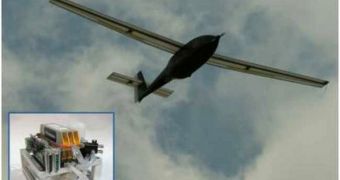Over recent years, robotic spy planes and unmanned drones have helped armies around the world take the best decisions for a specific situation on the battlefield. This ability stems from the fact that these aircrafts are perfectly capable of supplying their commanders with live feeds from the hot spot. Now, innovation reaches these devices as well. Experts are currently trying to implement renewable fuel capability in the precious devices, which could see them getting a longer range and increased stealthiness, LiveScience reports.
According to scientists, air drones equipped with this type of capabilities could easily be used in civilian applications as well, such as for the monitoring of wildfires, or of protected areas, where endangered species roam. One of the main benefits of running an engine on renewable fuel is the fact that the noise levels are considerably reduced. In the case of military applications, spying on a target that is aware of your presence is pointless.
Until now, unmanned aerial vehicles (UAV) commanders had to deploy their assets at very high altitudes, in order to counteract the noise problem. However, that will no longer be the case with the new approach, and so the eyes-in-the-sky will be able to supply ever more information than they do now. This is especially important when considering that, at this point, these machines are used in areas and missions where sending a human pilot is considered a bad judgment call.
“Think about lawnmowers or chainsaws – they're really loud. It's hard to spy on people when they know you're there, so you had to fly them at high altitudes to keep them from being heard,” explains Karen Swider-Lyons. The researcher is the head of the alternative energy section at the Washington-based Naval Research Laboratory. Thus far, some researchers have been funded by the NRL to produce alternatives to internal combustion engines, but battery technology is not yet sufficiently advanced to allow for that.
“The problem there is that batteries don't have the endurance of internal combustion engines. It's the same issue you see with electric cars,” Swider-Lyons says. But the new UAV is currently capable of flying off renewable sources. Known as the “Ion Tiger” UAV, the machine makes excellent use of hydrogen fuel cells, which allow it to go farther than its batter-powered cousins, at the same time being stealthier than its internal combustion engine-powered counterparts.

 14 DAY TRIAL //
14 DAY TRIAL //